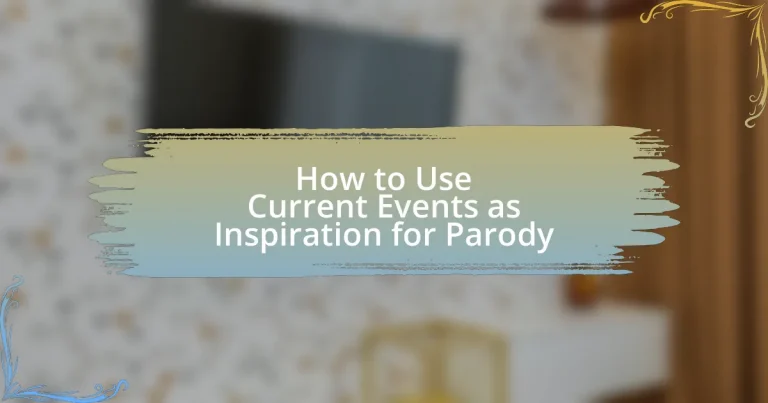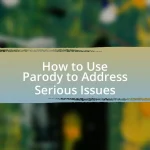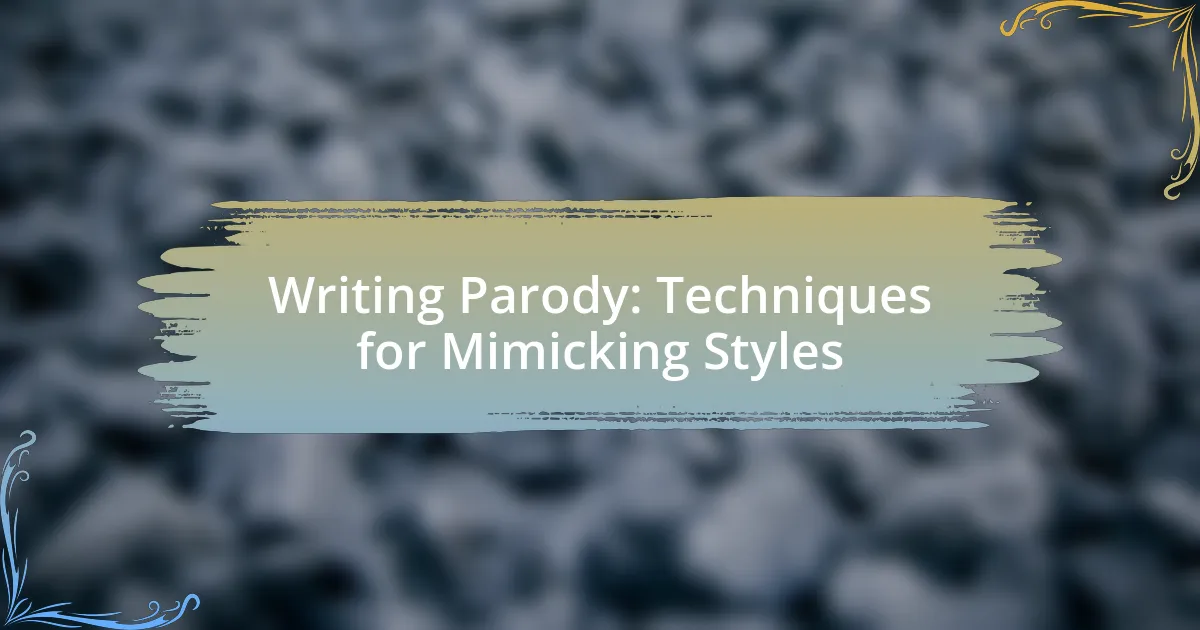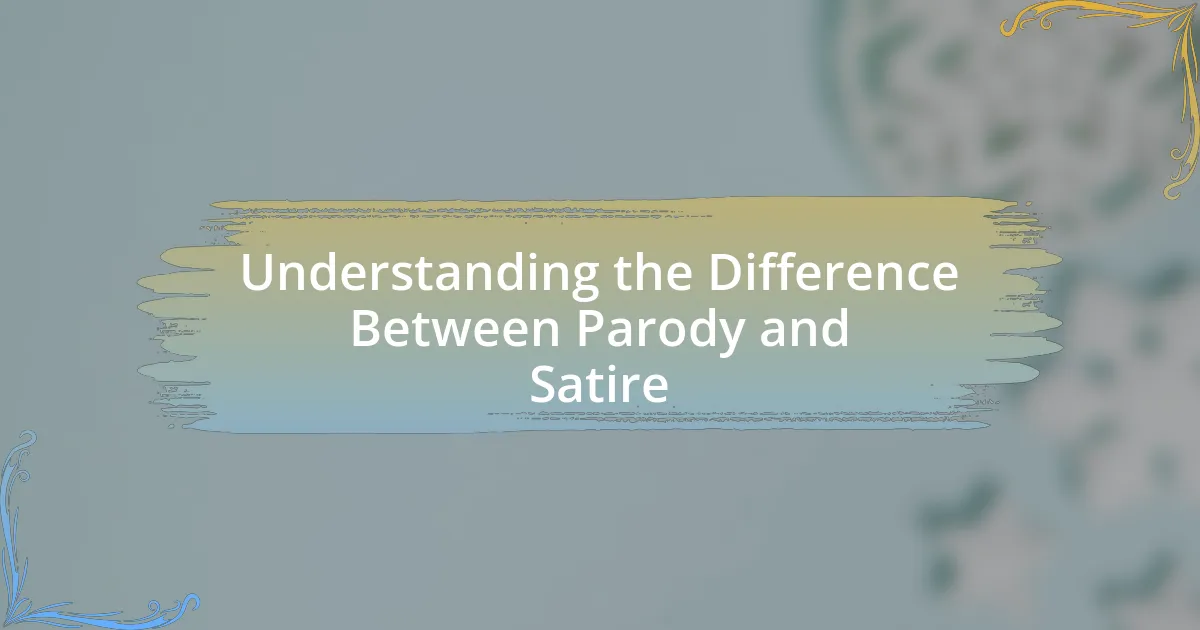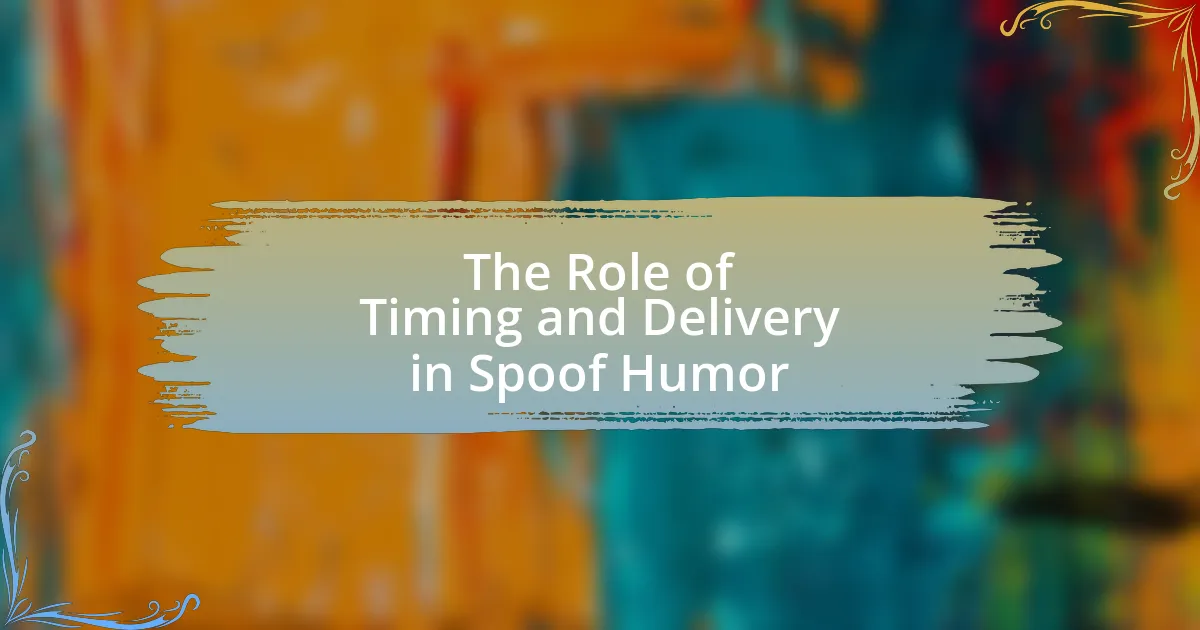The article explores the role of current events as a vital source of inspiration for parody, emphasizing how contemporary issues resonate with audiences and enhance comedic impact. It discusses the effectiveness of political events, celebrity news, and social issues as subjects for satire, highlighting techniques such as exaggeration, irony, and juxtaposition. Additionally, the article outlines best practices for crafting successful parodies, including the importance of relevance, audience engagement, and avoiding common pitfalls. By analyzing how humor can facilitate social critique, the article provides insights into the creation and impact of parody in relation to current events.
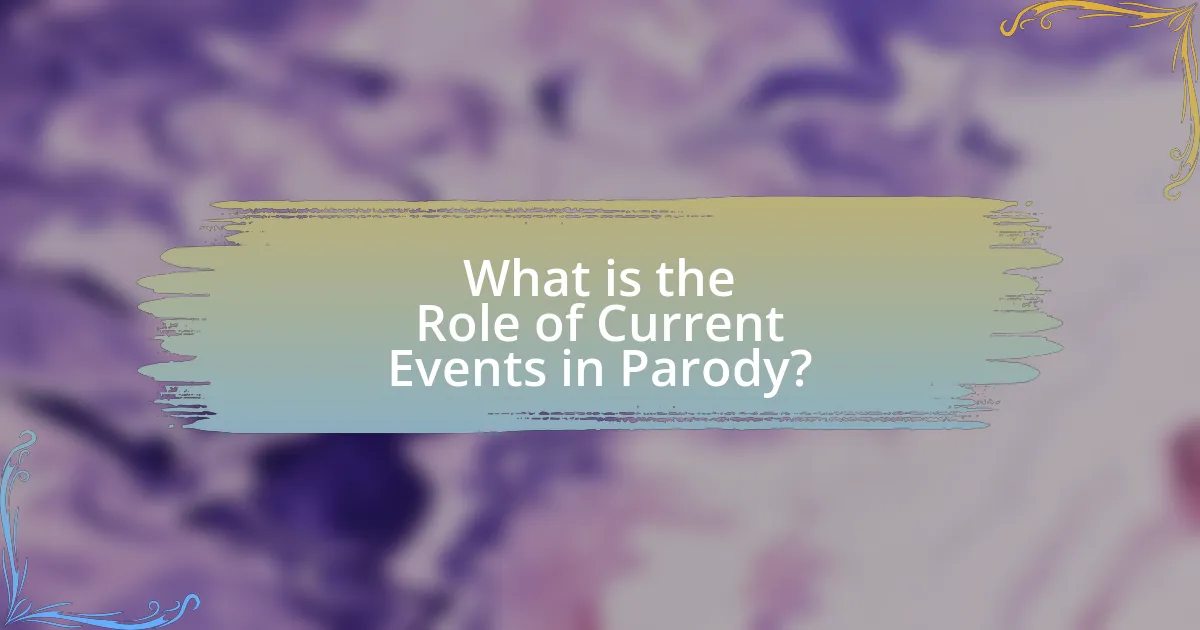
What is the Role of Current Events in Parody?
Current events serve as a critical source of inspiration for parody by providing relevant and relatable material that resonates with audiences. Parody often relies on the familiarity of contemporary issues, allowing creators to satirize or critique societal norms, political figures, and cultural phenomena. For instance, the use of political scandals or viral news stories in parody can amplify the comedic effect, as these events are fresh in the public’s mind, making the humor more impactful. This connection to current events not only enhances the relevance of the parody but also engages audiences who are already discussing or reacting to these topics, thereby increasing the likelihood of the parody being shared and appreciated.
How can current events serve as a source of inspiration for parody?
Current events can serve as a source of inspiration for parody by providing relatable and timely material that resonates with audiences. Parody often relies on exaggeration and humor to critique or comment on societal issues, and current events offer a rich tapestry of political, social, and cultural happenings that can be satirized. For example, the political landscape during election seasons frequently generates parodic content, as seen in shows like “Saturday Night Live,” which uses real-life political figures and events to create comedic sketches that reflect public sentiment. This approach not only entertains but also encourages critical thinking about the subjects being parodied, making current events a vital resource for parody creators.
What types of current events are most effective for parodying?
Political events are the most effective for parodying due to their inherent drama and public interest. High-profile political scandals, elections, and controversial legislation often provide rich material for satire, as they evoke strong emotional responses and are widely discussed in media. For instance, the impeachment trials of U.S. presidents have historically been parodied in various forms of media, highlighting the absurdities and contradictions within the political process. Additionally, celebrity news and social issues, such as climate change debates or public health crises, also serve as effective subjects for parody, as they resonate with audiences and reflect societal concerns.
How do cultural and political contexts influence parody creation?
Cultural and political contexts significantly influence parody creation by shaping the themes, targets, and reception of the parody. For instance, during politically charged periods, such as elections or social movements, parodies often focus on political figures or policies, reflecting public sentiment and critique. Historical examples include the satirical works of “Saturday Night Live” during U.S. presidential elections, which highlight the absurdities of candidates and their platforms, resonating with audiences who are engaged in the political discourse. Additionally, cultural norms and values dictate what is considered acceptable or humorous, guiding creators in their choice of subjects and styles. For example, parodies that challenge societal taboos may provoke stronger reactions, as seen in the works of comedians like John Oliver, who often tackle controversial issues, thereby influencing public opinion and sparking dialogue.
Why is parody an effective tool for commentary on current events?
Parody is an effective tool for commentary on current events because it allows for the critique of societal issues through humor and exaggeration. This method engages audiences by making complex topics more accessible and relatable, often highlighting absurdities in political or social situations. For instance, shows like “Saturday Night Live” use parody to satirize political figures, which can lead to increased public awareness and discussion about their actions. Research indicates that humor can enhance retention of information, making parody a powerful vehicle for conveying messages about current events.
How does humor enhance the impact of social critique?
Humor enhances the impact of social critique by making complex or sensitive issues more accessible and engaging to a wider audience. When humor is employed, it can disarm the audience, allowing them to confront uncomfortable truths without feeling defensive. For instance, satirical programs like “Saturday Night Live” effectively highlight political absurdities, prompting viewers to reflect on societal issues while being entertained. Research indicates that humor can increase retention of information and foster critical thinking, as it encourages audiences to question norms and assumptions in a less confrontational manner. This dual function of humor—entertaining while provoking thought—amplifies the effectiveness of social critique.
What are the risks and rewards of using parody in commentary?
Using parody in commentary carries both risks and rewards. The primary reward is that parody can effectively highlight social issues and provoke thought, as seen in works like “Saturday Night Live,” which uses humor to critique political figures and policies, thereby engaging audiences in important conversations. Conversely, the main risk involves potential backlash, as parody can be misinterpreted or deemed offensive, leading to public outrage or legal challenges, exemplified by controversies surrounding satirical depictions of religious figures. Thus, while parody can serve as a powerful tool for commentary, it requires careful consideration of its impact and audience reception.

How to Identify Suitable Current Events for Parody?
To identify suitable current events for parody, focus on events that are widely recognized, controversial, or absurd. These events often generate strong public reactions, making them ripe for satire. For instance, political scandals or celebrity mishaps frequently attract attention and can be effectively parodied due to their inherent drama and public interest. Additionally, events that highlight societal issues, such as economic crises or public health debates, provide rich material for parody as they resonate with audiences and provoke thought. The effectiveness of parody often hinges on the event’s relevance and the emotional responses it elicits, as seen in the success of parodies related to major news stories that dominate media coverage.
What criteria should be used to select current events for parody?
Current events selected for parody should be significant, relatable, and controversial. Significant events capture public attention and have a wide impact, making them ideal for parody. Relatable events resonate with audiences, allowing them to connect emotionally and understand the humor. Controversial events provide fertile ground for satire, as they often provoke strong opinions and reactions, enhancing the comedic effect. For instance, political scandals or major social issues frequently serve as effective subjects for parody due to their relevance and the public’s engagement with them.
How do relevance and public interest affect the choice of events?
Relevance and public interest significantly influence the choice of events by determining which topics resonate most with audiences. Events that are timely and widely discussed attract more attention, making them ideal for parody. For instance, during major political elections, satirical content often focuses on candidates and their policies, as these subjects are highly relevant and engage the public’s interest. This correlation is supported by data showing that parodies of current events, such as those featured on platforms like Saturday Night Live, often achieve higher viewership when they address trending topics, reflecting the audience’s desire for commentary on issues they are already invested in.
What role does timing play in the effectiveness of a parody?
Timing is crucial in the effectiveness of a parody because it determines the relevance and resonance of the content with the audience. When a parody is released shortly after a significant event, it capitalizes on the audience’s heightened awareness and emotional response, making the humor more impactful. For instance, parodies of political events or viral trends often gain traction quickly because they tap into the collective consciousness, allowing for immediate recognition and engagement. Historical examples, such as “Saturday Night Live” sketches that air shortly after major political debates, illustrate how timely parodies can influence public discourse and enhance comedic effect.
How can one analyze current events for parody potential?
To analyze current events for parody potential, one should identify absurdities, contradictions, or exaggerated elements within the events. This involves closely examining news stories, public reactions, and the behavior of key figures to uncover humorous angles. For instance, the 2020 U.S. presidential election showcased numerous instances of hyperbole and dramatic statements that became ripe for parody, as seen in various satirical shows that highlighted the absurdity of political debates and social media interactions. By focusing on these elements, one can effectively create parodies that resonate with audiences familiar with the context.
What techniques can be used to dissect news stories for humor?
Techniques to dissect news stories for humor include satire, exaggeration, irony, and juxtaposition. Satire allows for the critique of societal issues by mimicking the style of the original news source while highlighting absurdities. Exaggeration amplifies certain elements of the story to an unrealistic degree, making them humorous. Irony creates a contrast between expectations and reality, often revealing the ridiculousness of a situation. Juxtaposition places two contrasting ideas or images side by side, enhancing the comedic effect by highlighting their differences. These techniques are effective because they engage the audience’s critical thinking while providing entertainment, as evidenced by the success of satirical programs like “The Daily Show” and “Saturday Night Live,” which utilize these methods to comment on current events.
How can one identify absurdities or contradictions in current events?
One can identify absurdities or contradictions in current events by critically analyzing statements, actions, and outcomes against established facts and logical reasoning. This involves examining news reports, official statements, and social media narratives for inconsistencies or illogical conclusions. For example, a government may claim to support environmental policies while simultaneously approving fossil fuel projects, highlighting a contradiction between stated values and actions. Fact-checking organizations, such as PolitiFact and Snopes, provide evidence-based assessments that can help clarify these discrepancies, reinforcing the identification of absurdities in public discourse.
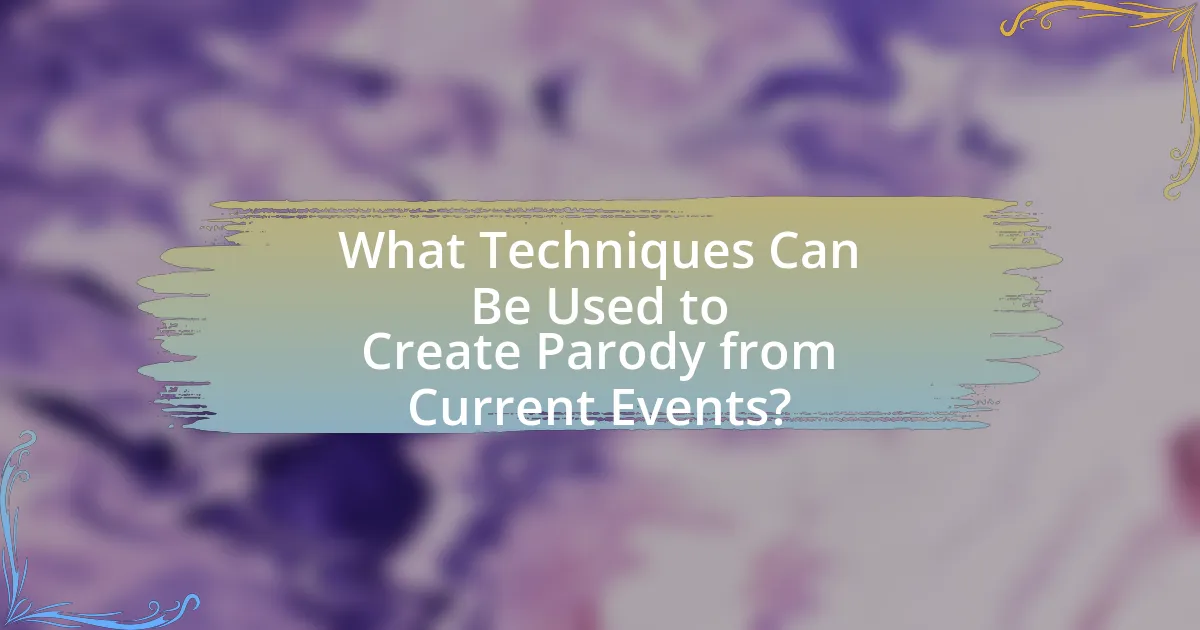
What Techniques Can Be Used to Create Parody from Current Events?
Techniques to create parody from current events include exaggeration, satire, and juxtaposition. Exaggeration amplifies characteristics or behaviors of public figures or situations to highlight absurdity, as seen in shows like “Saturday Night Live.” Satire critiques societal norms or politics through humor, often using irony to expose flaws, similar to the work of Jonathan Swift. Juxtaposition places contrasting elements side by side to create humor or provoke thought, effectively used in cartoons that compare political leaders’ actions with historical events. These techniques are effective because they resonate with audiences familiar with the events being parodied, making the humor relatable and impactful.
How can writers develop a unique voice in their parodies?
Writers can develop a unique voice in their parodies by incorporating personal experiences and perspectives that resonate with contemporary issues. This approach allows them to create a distinctive style that reflects their individuality while engaging with current events. For instance, using satire to comment on political situations or social trends can enhance the humor and relevance of the parody. Additionally, experimenting with language, tone, and structure can further differentiate their voice. Research indicates that parody often thrives on the juxtaposition of familiar elements with unexpected twists, which can be achieved through a writer’s unique lens on current events.
What stylistic choices enhance the comedic effect of a parody?
Stylistic choices that enhance the comedic effect of a parody include exaggeration, incongruity, and satire. Exaggeration amplifies characteristics or behaviors of the original subject, making them absurd and humorous; for example, a parody of a politician might depict them as overly dramatic or incompetent. Incongruity arises when there is a mismatch between expectations and reality, such as placing a serious character in a ridiculous situation, which creates humor through surprise. Satire critiques societal norms or behaviors, using humor to highlight flaws, as seen in parodies that mock cultural phenomena or current events. These stylistic elements work together to create a comedic impact that resonates with audiences, making the parody both entertaining and thought-provoking.
How can exaggeration and satire be effectively employed?
Exaggeration and satire can be effectively employed by amplifying the absurdities of current events to highlight societal issues and provoke thought. This technique allows creators to draw attention to the ridiculousness of certain behaviors or policies, making the audience more aware of underlying truths. For instance, political cartoons often exaggerate features of public figures to critique their actions, thereby encouraging viewers to reflect on the implications of those actions. Historical examples, such as Jonathan Swift’s “A Modest Proposal,” demonstrate how satire can address serious social problems through hyperbolic suggestions, prompting readers to reconsider their perspectives on real issues.
What formats can be used for parodying current events?
Parodying current events can be effectively achieved through various formats, including satire, sketch comedy, memes, and editorial cartoons. Each format allows for a unique approach to critique or humorously reflect on real-world happenings. For instance, satire often employs exaggeration and irony to highlight societal issues, while sketch comedy can dramatize events in a humorous narrative. Memes leverage visual elements and concise text to quickly convey humor related to current events, and editorial cartoons use illustrations to provide commentary on political or social issues. These formats have been widely utilized in media, demonstrating their effectiveness in engaging audiences with contemporary topics.
How do different media (e.g., written, video, social media) affect parody style?
Different media significantly influence parody style by shaping the methods of expression and audience engagement. Written media allows for nuanced language and detailed satire, often relying on wit and clever wordplay, while video media enhances parody through visual elements, timing, and performance, making it more immediate and impactful. Social media, on the other hand, facilitates rapid dissemination and interaction, enabling parodies to evolve quickly and reach diverse audiences, often incorporating memes and user-generated content. For instance, the viral nature of social media platforms like Twitter and TikTok allows parodies to gain traction and adapt in real-time, reflecting current events and cultural trends more dynamically than traditional media.
What are some successful examples of current event parodies in various formats?
Successful examples of current event parodies include “Saturday Night Live,” which often features political sketches that satirize recent news events, such as their impersonations of political figures during election seasons. Another example is “The Onion,” a satirical news website that publishes articles parodying current events, like their coverage of major political scandals. Additionally, “The Daily Show” employs a comedic format to critique news stories and political happenings, effectively blending humor with commentary. These formats demonstrate how parody can effectively engage audiences by reflecting on and exaggerating real-world events.
What are the best practices for crafting a successful parody?
The best practices for crafting a successful parody include understanding the original work, using humor effectively, and ensuring relevance to current events. Understanding the original work allows the creator to identify key themes and elements that can be exaggerated or twisted for comedic effect. Effective humor often relies on wit, timing, and cultural references that resonate with the audience. Ensuring relevance to current events enhances the parody’s impact, as it connects with the audience’s experiences and interests, making the satire more relatable and engaging. For instance, successful parodies like “Saturday Night Live” often draw from contemporary political events, showcasing how timely references can amplify comedic value.
How can one ensure that the parody resonates with the audience?
To ensure that the parody resonates with the audience, one must align the content with current events that are relevant and relatable to the target demographic. By incorporating familiar cultural references and shared experiences, the parody becomes more engaging and impactful. For instance, a study by the Pew Research Center indicates that humor related to contemporary issues tends to elicit stronger emotional responses, making the content more memorable and enjoyable. Additionally, using a tone that reflects the audience’s sentiments—whether it be satire, irony, or absurdity—can enhance the connection, as humor often serves as a reflection of societal attitudes and beliefs.
What common pitfalls should be avoided when creating parody from current events?
When creating parody from current events, it is crucial to avoid misrepresentation of facts, as this can lead to misinformation and damage credibility. Misleading portrayals can confuse audiences and undermine the intended humor. Additionally, it is important to steer clear of insensitivity towards serious issues, as this can alienate audiences and provoke backlash. Parody should also avoid being overly complex or obscure, as this can hinder audience understanding and appreciation. Lastly, creators should refrain from relying on stereotypes, as this can perpetuate harmful narratives and detract from the parody’s effectiveness.
What tips can help in refining parody skills related to current events?
To refine parody skills related to current events, one effective tip is to stay informed about the latest news and trends. Regularly consuming diverse media sources, such as newspapers, online articles, and social media platforms, allows for a deeper understanding of the context and nuances of current events. This knowledge enables the identification of absurdities or contradictions within the news, which are essential elements for crafting effective parody. Additionally, analyzing successful parodies can provide insights into techniques and styles that resonate with audiences, further enhancing one’s ability to create impactful content.
